The Wheel Of Life
Buddhists do not believe that death is the end of life. When one dies, one's consciousness leaves and enters one of the six paths of rebirth.
Heavenly Beings
Humans
Asuras are beings who have many good things in life, but still like to fight. They appear in the heavens or on earth as people or animals.
Hungry ghosts are beings who suffer from constant hunger.
Hell-beings
These are the six states on the wheel of life. At the top are the heavens, where everyone is happy. Below are the hells where the suffering is unbearable. Beings can rise or fall from one path to another. If one does good deeds, one will be born into the paths of gods, humans, or asuras. If one does evil deeds, one will be born into the paths of animals, hungry ghosts, or hell-beings. From one life to the next one can suddenly change from an human to an animal or from a ghost to a hell-being, according to the things one has done.
How to Escape the Turning Wheel
The wheel of life and death is kept turning by the three poisons of greed, hatred, and stupidity. By cutting off the three poisons, we can escape the wheel and become enlightened. There are four stages of enlightenment.
Buddhas- perfect in enlightenment.
Bodhisattvas- enlighten themselves as well as others.
Pratyekabuddhas- hermits who retreat from the world to enlighten themselves.
Arhats- enlighten themselves.
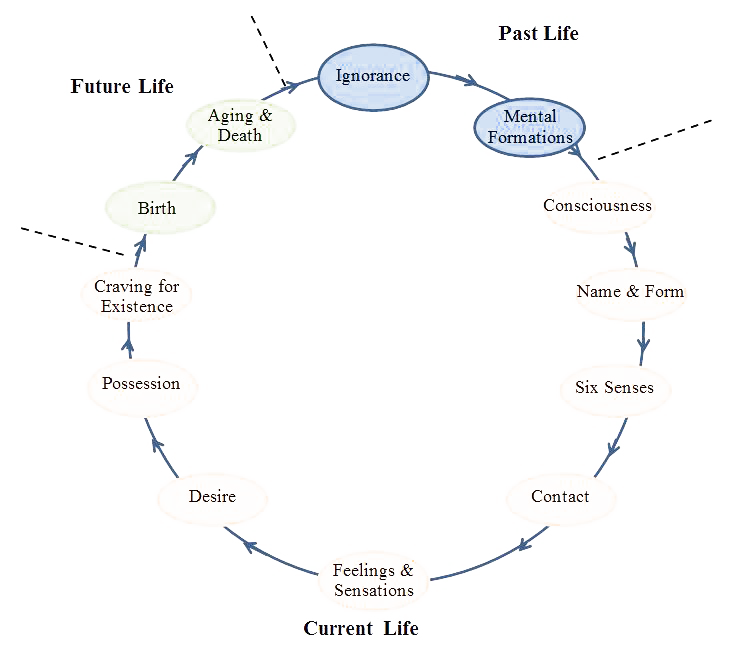
(1) Change (2) Suffering (3) no 'I'
The first, Change, points out the basic fact that nothing in the world is fixed or permanent. We ourselves are not the same people, either physically, emotionally or mentally, that we were ten years - or even ten minutes ago! Living as we do, then, as shifting beings upon shifting sands, it is not possible for us to find lasting security.
As regards the second Sign, we have already seen how it was the experience of Suffering that sent the Buddha off on his great spiritual quest, though suffering is not a very good translation of the original word, dukkha. Dukkha implies the generally unsatisfactory and imperfect nature of life. However, it does not follow that Buddhists believe that life is all suffering. Buddhists do believe that there is happiness in life, but know that it does not last and that even in the most fortunate of lives there is suffering. Happiness is subject to the law of change and impermanence.
No-I, the third Sign, is a little more difficult.
Buddhists do not believe that there is anything everlasting or unchangeable in human beings, no soul or self in which a stable sense of 'I' might anchor itself. The whole idea of 'I' is in fact a basically false one that tries to set itself up in an unstable and temporary collection of elements. Take the traditional analogy of a cart. A cart may be broken down into its basic components -axle, wheels, shafts, sides, etc. Then the cart is no more; all we have is a pile of components. In the same way 'I' am made up of various elements or aggregates (khandhas): form (rupa-khandha), feeling-sensation (pleasant, unpleasant, neutral), (vedana-khandha), perception (sanna-khandha), volitional mental activities (sankhara-khandha), sense consciousness (vinnana-khandha).
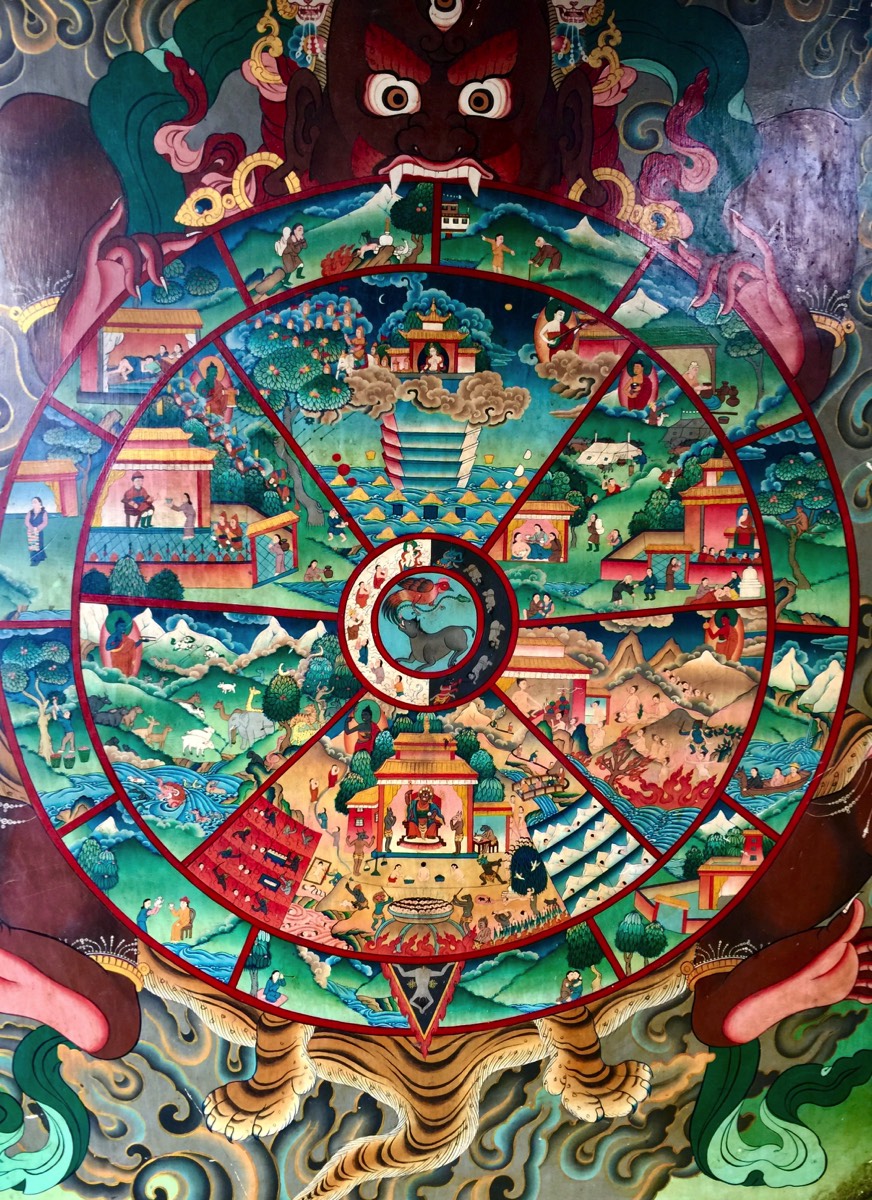
The rich iconography of the Wheel of Life can be interpreted on several levels. The six major sections represent the Six Realms. These realms can be understood as forms of existence, or states of mind, into which beings are born according to their karma. The realms also can be viewed as situations in life or even personality types — hungry ghosts are addicts; devas are privileged; hell beings have anger issues.
In each of the realms the Bodhisattva Avalokiteshvara appears to show the way to liberation from the Wheel. But liberation is possible only in the human realm. From there, those who realize enlightenment find their way out of the Wheel to Nirvana.
The gallery shows sections of the Wheel and explains them in more detail.
The Wheel of Life is one of the most common subjects of Buddhist art. The detailed symbolism of the Wheel can be interpreted on many levels.
The Wheel of Life (called the Bhavachakra in Sanskrit) represents the cycle of birth and rebirth and existence in samsara.
This gallery looks at different parts of the Wheel and explains what they mean. The main sections are the hub and the six "pie wedges" depicting the Six Realms. The gallery also looks at the Buddha figures in the corners and at Yama, the fearsome creature holding the Wheel in his hooves.
Many Buddhists understand the Wheel in an allegorical, not literal, way. As you examine the parts of the wheel you might find yourself relating to some of it personally or recognizing people you know as Jealous Gods or Hell Beings or Hungry Ghosts.
The outer circle of the Wheel (not shown in detail in this gallery) is the Paticca Samuppada, the Links of Dependent Origination. Traditionally, the outer wheel depicts a blind man or woman (representing ignorance); potters (formation); a monkey (consciousness); two men in a boat (mind and body); a house with six windows (the senses); an embracing couple (contact); an eye pierced by an arrow (sensation); a person drinking (thirst); a man gathering fruit (grasping); a couple making love (becoming); a woman giving birth (birth); and a man carrying a corpse (death).
In each of the realms the Bodhisattva Avalokiteshvara appears to show the way to liberation from the Wheel. But liberation is possible only in the human realm. From there, those who realize enlightenment find their way out of the Wheel to Nirvana.
The gallery shows sections of the Wheel and explains them in more detail.
The Wheel of Life is one of the most common subjects of Buddhist art. The detailed symbolism of the Wheel can be interpreted on many levels.
The Wheel of Life (called the Bhavachakra in Sanskrit) represents the cycle of birth and rebirth and existence in samsara.
This gallery looks at different parts of the Wheel and explains what they mean. The main sections are the hub and the six "pie wedges" depicting the Six Realms. The gallery also looks at the Buddha figures in the corners and at Yama, the fearsome creature holding the Wheel in his hooves.
Many Buddhists understand the Wheel in an allegorical, not literal, way. As you examine the parts of the wheel you might find yourself relating to some of it personally or recognizing people you know as Jealous Gods or Hell Beings or Hungry Ghosts.
The outer circle of the Wheel (not shown in detail in this gallery) is the Paticca Samuppada, the Links of Dependent Origination. Traditionally, the outer wheel depicts a blind man or woman (representing ignorance); potters (formation); a monkey (consciousness); two men in a boat (mind and body); a house with six windows (the senses); an embracing couple (contact); an eye pierced by an arrow (sensation); a person drinking (thirst); a man gathering fruit (grasping); a couple making love (becoming); a woman giving birth (birth); and a man carrying a corpse (death).
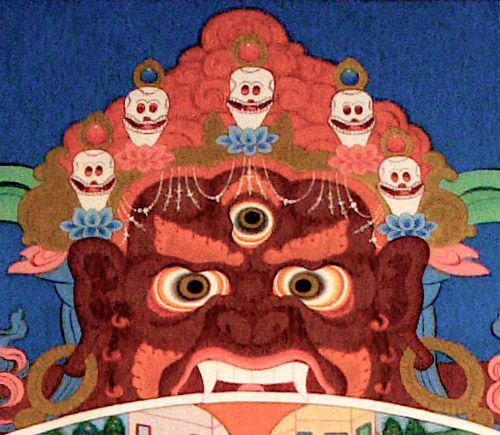
The Wrathful Dharmapala of Hell Yama, Lord of the Underworld, represents death and holds the wheel in his hooves.
MarenYumi/Flickr
The creature holding the Wheel of Life in his hooves is Yama, the wrathful dharmapala who is Lord of the Hell Realm.
The terrible face of Yama, who represents impermanence, peers over the top of the Wheel. In spite of his appearance, Yama is not evil. He is a wrathful dharmapala, a creature devoted to protecting Buddhism and Buddhists. Although we may be frightened of death, it is not evil; just inevitable.
In legend, Yama was a holy man who believed he would realize enlightenment if he meditated in a cave for 50 years. In the 11th month of the 49th year, robbers entered the cave with a stolen bull and cut off the bull's head. When they realized the holy man had seen them, the robbers cut off his head also.
But the holy man put on the bull's head and assumed the terrible form of Yama. He killed the robbers, drank their blood, and threatened all of Tibet. He could not be stopped until Manjushri, Bodhisattva of Wisdom, manifested as the even more terrible dharmapala Yamantaka and defeated Yama. Yama then became a protector of Buddhism.
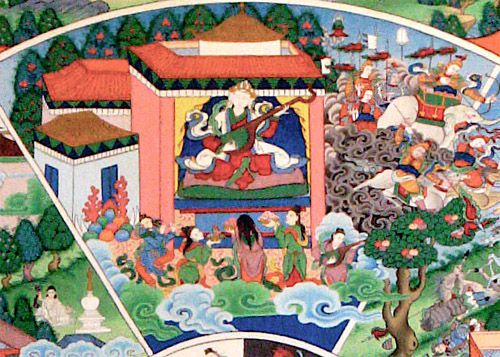
Being a God Isn't Perfect The Realm of the Gods of the Bhavachakra.
The Realm of the Gods (Devas) is the highest realm of the Wheel of Life and is always depicted at the top of the Wheel.
The Realm of the Gods (Devas) sounds like a nice place to live. And, no question, you can do a lot worse. But even the Realm of the Gods isn't perfect. Those born in the God Realm live long and pleasure-filled lives. They have wealth and power and happiness. So what's the catch?
The catch is that because the Devas have such rich and happy lives they don't recognize the truth of suffering. Their happiness is, in a way, a curse, because they have no motivation to seek liberation from the Wheel. Eventually, their happy lives end, and they must face rebirth in another, less happy, realm.
The Devas are perpetually at war with their neighbors on the Wheel, the Asuras. This depiction of the Wheel shows the Devas charging the Asuras.
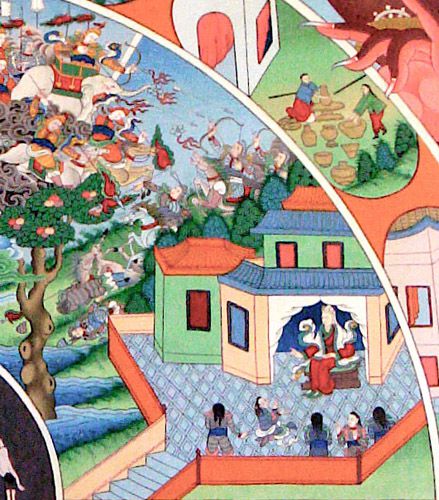
Jealous Gods and Paranoia The Realm of Asuras, also called Jealous Gods or Titans.
The Asura (Jealous God) Realm is marked by paranoia.
Asuras are hyper-competitive and paranoid. They are driven by a desire to beat their competition, and everyone is competition. They have power and resources and sometimes accomplish good things with them. But, always, their first priority is getting to the top. I think of powerful politicians or corporate leaders when I think of Asuras.
Chih-i (538-597), a patriarch of the T'ien-t'ai school, described the Asura this way: "Always desiring to be superior to others, having no patience for inferiors and belittling strangers; like a hawk, flying high above and looking down on others, and yet outwardly displaying justice, worship, wisdom, and faith — this is raising up the lowest order of good and walking the way of the Asuras."
Asuras, who are also called "anti-gods," are perpetually at war with the Devas of the God Realm. Asuras think they belong in the God Realm and fight to get in, although here it seems the Asuras have formed a line of defense and are fighting the attacking Devas with bows and arrows. Some depictions of the Wheel of Life combine the Asura and God realms into one.
Sometimes there is a beautiful tree growing between the two realms, with its roots and trunk in the Asura Realm. But its branches and fruit are in the God Realm.
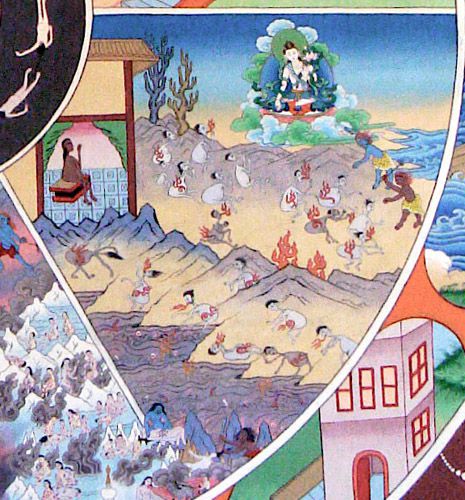
Craving That Can Never Be Satisfied The Realm of Hungry Ghosts.
Hungry Ghosts have huge, empty stomachs, but their thin necks don't allow nourishment to pass. Food turns to fire and ash in their mouths.
Hungry Ghosts (Pretas) are pitable things. They are wasted creatures with huge, empty stomachs. Their necks are too thin to allow food to pass. So, they are constantly hungry.
Greed and jealousy lead to rebirth as a Hungry Ghost. The Hungry Ghost Realm often, but not always, is depicted between the Asura Realm and the Hell Realm. It is thought the karma of their lives was not quite bad enough for a rebirth in the Hell Realm but not good enough for the Asura Realm.
Psychologically, Hungry Ghosts are associated with addictions, compulsions and obsessions. People who have everything but always want more may be Hungry Ghosts.
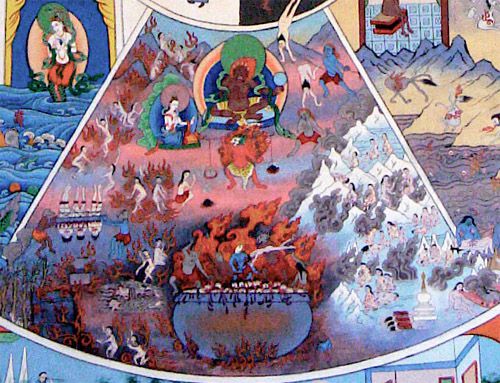
Fire and Ice The Hell Realm of the Wheel of Life.
The Hell Realm is marked by anger, terror and claustrophobia.
The Hell Realm is depicted as a place partly of fire and partly of ice. In the fiery part of the realm, Hell Beings (Narakas) are subjected to pain and torment. In the icy part, they are frozen.
Interpreted psychologically, Hell Beings are recognized by their acute aggression. Fiery Hell Beings are angry and abusive, and they drive away anyone who would befriend or love them. Icy Hell Beings shove others away with their unfeeling coldness. Then, in the torment of their isolation, their aggression increasingly turns inward, and they become self-destructive.
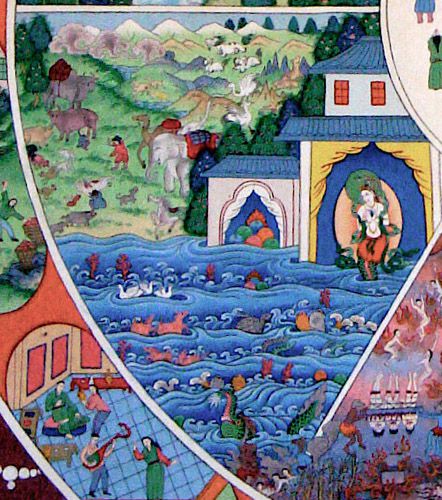
No Sense of Humor The Animal Realm of the Wheel of Life.
Animal Beings (Tiryakas) are solid, regular and predictable. They cling to what is familiar and are disinterested, even fearful, of anything unfamiliar.
The Animal Realm is marked by ignorance and complacency. Animal Beings are stolidly un-curious and are repelled by anything unfamiliar. They go through life seeking comfort and avoiding discomfort. They have no sense of humor.
Animal Beings may find contentment, but they easily become fearful when placed in a new situation. Naturally, they are bigoted and likely to remain so. At the same time, they are subject to oppression by other beings -- animals do devour each other, you know.
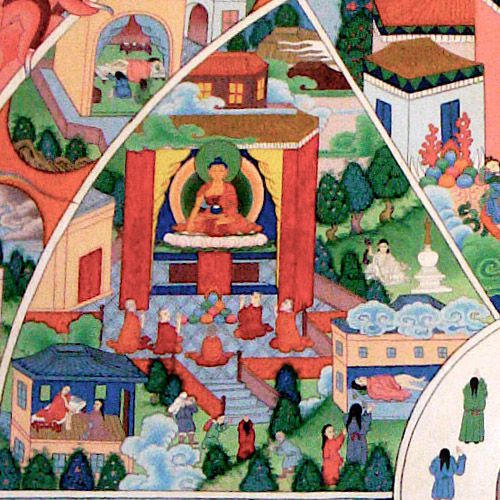
The Hope of Liberation The human realm of the Wheel of Life.
Liberation from the Wheel is possible only from the Human Realm.
The Human Realm is marked by questioning and curiosity. It is also a realm of passion; human beings (Manushyas) want to strive, consume, acquire, enjoy, explore. Here the Dharma is openly available, yet only a few seek it. The rest become caught up in striving, consuming and acquiring, and miss the opportunity.
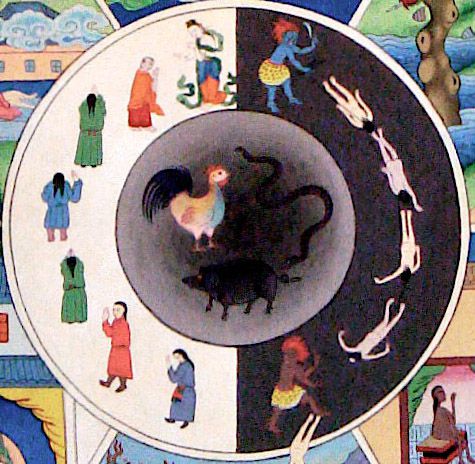
What Makes the Wheel Turn The center of the Wheel of Life.
At the center of the Wheel of Life are the forces that keep it turning — greed, anger and ignorance.
At the center of every Wheel of Life are a cock, a snake and a pig, which represent greed, anger and ignorance. In Buddhism, greed, anger (or hate) and ignorance are called the "Three Poisons" because they poison whoever harbors them. These are the forces that keep the Wheel of Life turning, according to the Buddha's teaching of the Second Noble Truth.
The circle outside the center, which is sometimes missing in depictions of the Wheel, is called the Sidpa Bardo, or intermediate state. It is also sometimes called the White Path and the Dark Path. On one side, bodhisattvas guide beings to rebirths in the higher realms of Devas, Gods and Humans. On the other, demons lead beings to the lower realms of Hungry Ghosts, Hell Beings and Animals.
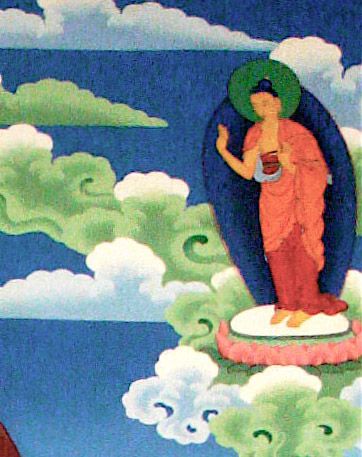
The Dharmakaya Buddha The Buddha.
In the upper right-hand corner of the Wheel of Life, the Buddha appears, representing hope for liberation.
In many depictions of the Wheel of Life, the figure in the upper right-hand corner is a Dharmakaya Buddha. The dharmakaya is sometimes called the Truth Body or the Dharma Body and is identified with shunyata. Dharmakaya is everything, unmanifested, free of characteristics and distinctions.
Often this Buddha is shown pointing to the moon, which represents enlightenment. However, in this version the Buddha stands with his hands raised, as if in blessing.
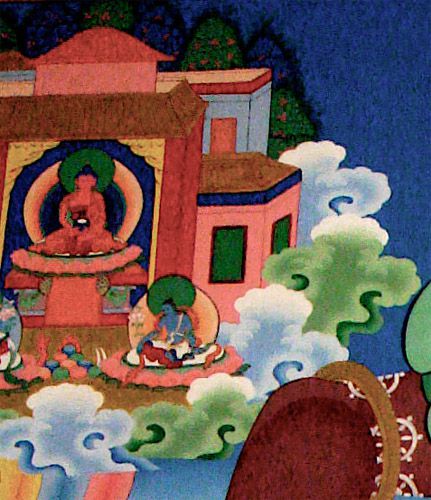
The upper left-hand corner of a Bhavachakra is filled with a scene or symbol representing liberation from the Wheel.
This depiction of the Wheel of Life shows the entry to Nirvana in the upper left-hand corner.
In the upper left-hand corner of this depiction of the Wheel of Life is a temple with a seated Buddha. A stream of beings rise from the Human Realms toward the temple, which represents Nirvana. Artists creating a Wheel of Life fill this corner in various ways. Sometimes the upper left-hand figure is a Nirmanakaya Buddha, representing bliss. Sometimes the artist paints a moon, which symbolizes liberation.

